Zhaohui Li
Towards Understanding Multi-Round Large Language Model Reasoning: Approximability, Learnability and Generalizability
Mar 05, 2025Abstract:Recent advancements in cognitive science and multi-round reasoning techniques for Large Language Models (LLMs) suggest that iterative thinking processes improve problem-solving performance in complex tasks. Inspired by this, approaches like Chain-of-Thought, debating, and self-refinement have been applied to auto-regressive LLMs, achieving significant successes in tasks such as mathematical reasoning, commonsense reasoning, and multi-hop question answering. Despite these successes, the theoretical basis for how multi-round reasoning enhances problem-solving abilities remains underexplored. In this work, we investigate the approximation, learnability, and generalization properties of multi-round auto-regressive models. We show that Transformers with finite context windows are universal approximators for steps of Turing-computable functions and can approximate any Turing-computable sequence-to-sequence function through multi-round reasoning. We extend PAC learning to sequence generation and demonstrate that multi-round generation is learnable even when the sequence length exceeds the model's context window. Finally, we examine how generalization error propagates across rounds, and show how the aforementioned approaches can help constrain this error, ensuring outputs stay within an expectation boundary. This work sheds light on the systemic theoretical foundations of multi-round sequence learning and reasoning, emphasizing its role in inference complexity.
Joint Training for Selective Prediction
Oct 31, 2024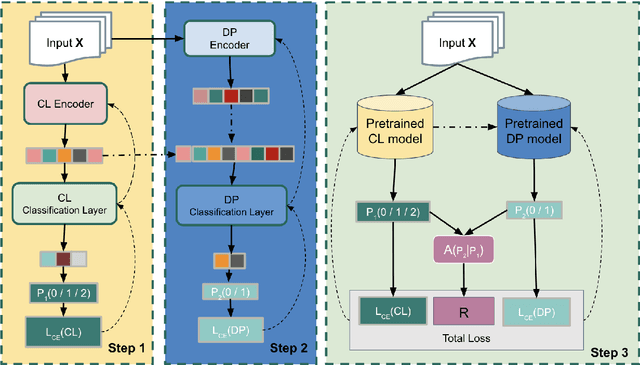
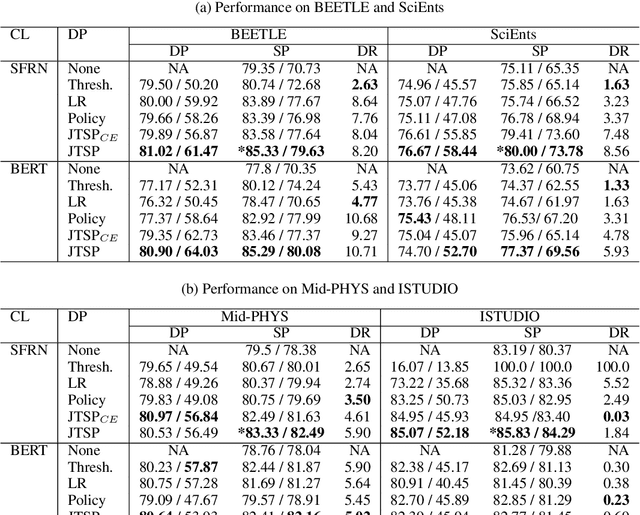
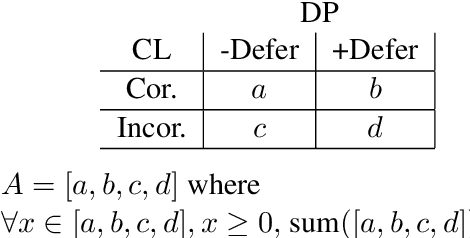

Abstract:Classifier models are prevalent in natural language processing (NLP), often with high accuracy. Yet in real world settings, human-in-the-loop systems can foster trust in model outputs and even higher performance. Selective Prediction (SP) methods determine when to adopt a classifier's output versus defer to a human. Previous SP approaches have addressed how to improve softmax as a measure of model confidence, or have developed separate confidence estimators. One previous method involves learning a deferral model based on engineered features. We introduce a novel joint-training approach that simultaneously optimizes learned representations used by the classifier module and a learned deferral policy. Our results on four classification tasks demonstrate that joint training not only leads to better SP outcomes over two strong baselines, but also improves the performance of both modules.
Simplified Self-homodyne Coherent System Based on Alamouti Coding and Digital Subcarrier Multiplexing
Mar 18, 2024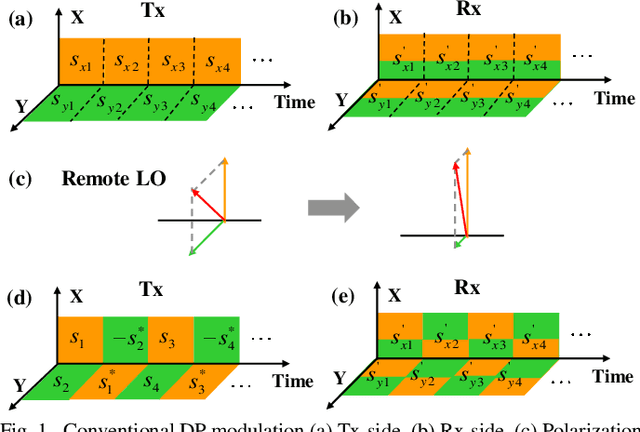
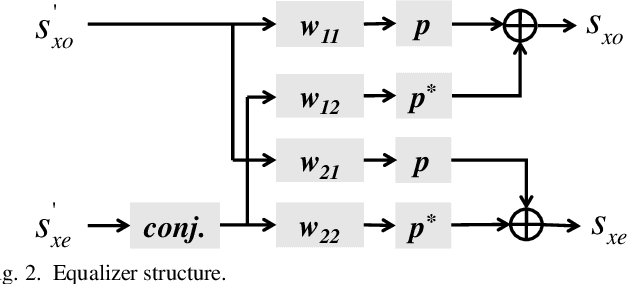
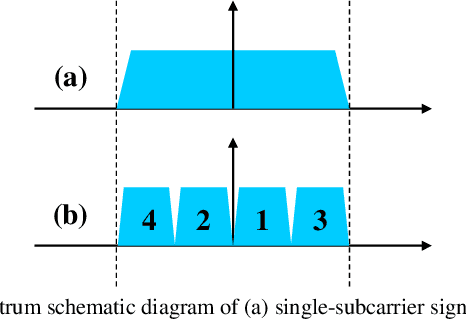
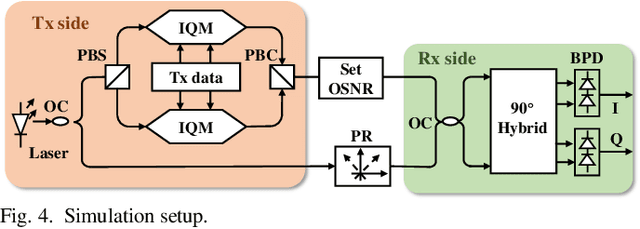
Abstract:Coherent technology inherent with more availabledegrees of freedom is deemed a competitive solution for nextgeneration ultra-high-speed short-reach optical interconnects.However, the fatal barriers to implementing the conventiona.coherent system in short-reach optical interconnect are the costfootprint, and power consumption. Self-homodyne coherentsystem exhibits its potential to reduce the power consumption ofthe receiver-side digital signal processing (Rx-DSP) by deliveringthe local oscillator (LO) from the transmitter. However, anautomatic polarization controller (APC) is inevitable in the remoteLO link to avoid polarization fading, resulting in additional costsTo address the polarization fading issue, a simplified self.homodyne coherent system is proposed enabled by Alamouticoding in this paper. Benefiting from the Alamouti coding betweentwo polarizations, a polarization-insensitive receiver onlyincluding a 3dB coupler, a 90o Hybrid, and two balancedphotodiodes (BPDs)is sufficient for reception. Meanwhile, theAPC in the LO link is needless, simplifying the receiver structuresignificantly. Besides, the digital subcarrier multiplexing (DSCM)technique is also adopted to relax the computational complexity ofthe chromatic dispersion compensation (CDC), which is one of thedominant power consumption modules in Rx-DSP. Thetransmission performance of 50Gbaud 4-subcarrier 16/32OAM(4SC-16/320AM) DSCM signal based on the proposed simplifiedself-homodyne coherent system is investigated experimentallyThe results show that the bit-error-ratio(BER) performancedegradation caused by CD can be solved by increasing 4 taps inthe equalizer for 80km single mode fiber(SMF)transmissionwithout individual CDC, which operates in a low-complexitymanner.
Pilot-Based Key Distribution and Encryption for Secure Coherent Passive Optical Networks
Nov 05, 2023
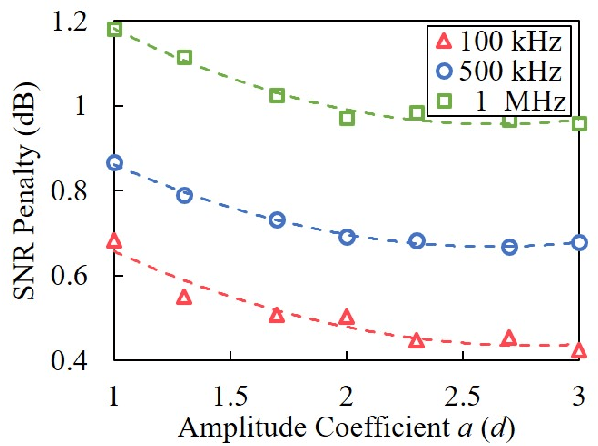
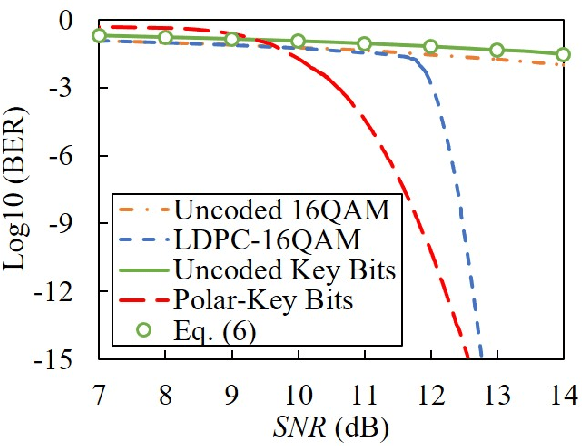
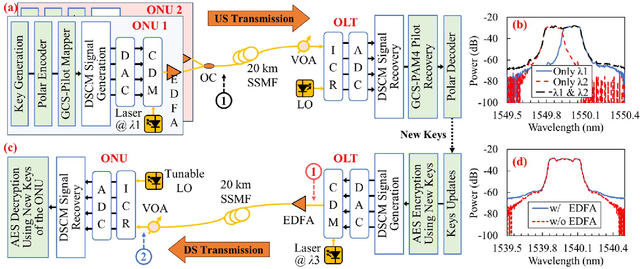
Abstract:The security issues of passive optical networks (PONs) have always been a concern due to broadcast transmission. Physical-layer security enhancement for the coherent PON should be as significant as improving transmission performance. In this paper, we propose the advanced encryption standard (AES) algorithm and geometric constellation shaping four-level pulse amplitude modulation (GCS-PAM4) pilot-based key distribution for secure coherent PON. The first bit of the GCS-PAM4 pilot is used for the hardware-efficient carrier phase recovery (CPR), while the second bit is utilized for key distribution without occupying the additional overhead. The key bits are encoded by the polar code to ensure error-free distribution. Frequent key updates are permitted for every codeword to improve the security of coherent PON. The experimental results of the 200-Gbps secure coherent PON using digital subcarrier multiplexing show that the GCS-PAM4 pilot-based key distribution could be error-free at upstream transmission without occupying the additional overhead and the eavesdropping would be prevented by AES algorithm at downstream transmission. Moreover, there is almost no performance penalty on the CPR using the GCS-PAM4 pilot compared to the binary phase shift keying pilot.
Capacity Limitation and Optimization Strategy for Flexible Point-to-Multi-Point Optical Networks
Oct 19, 2023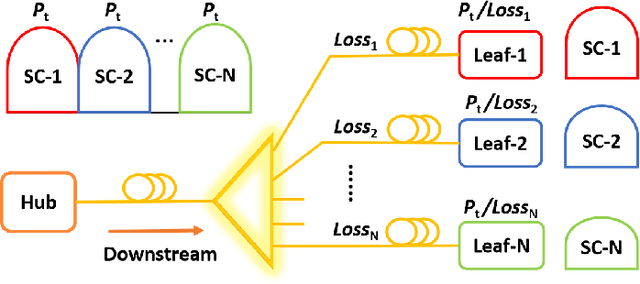
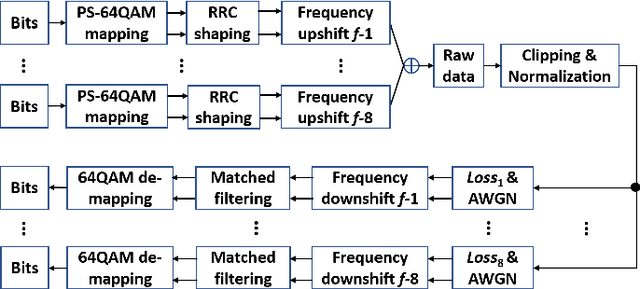
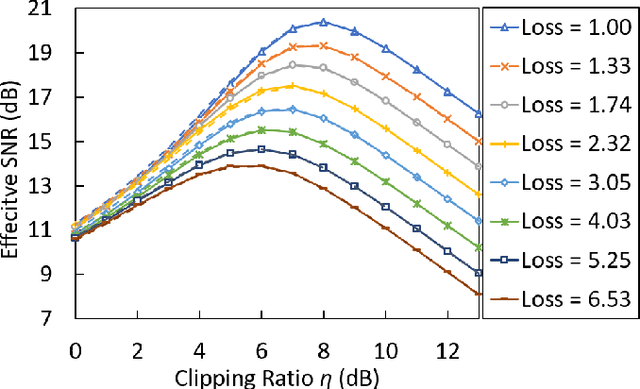
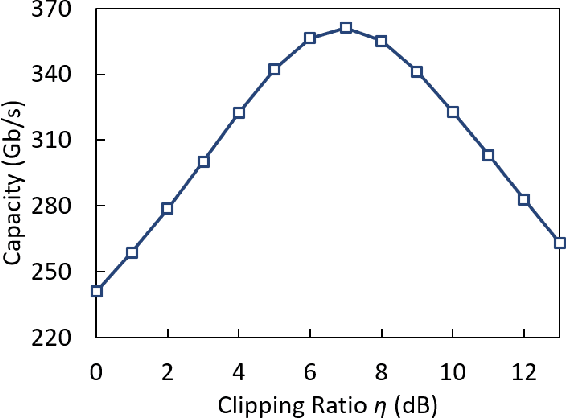
Abstract:Point-to-multi-point (PtMP) optical networks become the main solutions for network-edge applications such as passive optical networks and radio access networks. Entropy-loading digital subcarrier multiplexing (DSCM) is the core technology to achieve low latency and approach high capacity for flexible PtMP optical networks. However, the high peak-to-average power ratio of the entropy-loading DSCM signal limits the power budget and restricts the capacity, which can be reduced effectively by clipping operation. In this paper, we derive the theoretical capacity limitation of the flexible PtMP optical networks based on the entropy-loading DSCM signal. Meanwhile, an optimal clipping ratio for the clipping operation is acquired to approach the highest capacity limitation. Based on an accurate clipping-noise model under the optimal clipping ratio, we establish a three-dimensional look-up table for bit-error ratio, spectral efficiency, and link loss. Based on the three-dimensional look-up table, an optimization strategy is proposed to acquire optimal spectral efficiencies for achieving a higher capacity of the flexible PtMP optical networks.
AudioFormer: Audio Transformer learns audio feature representations from discrete acoustic codes
Aug 25, 2023
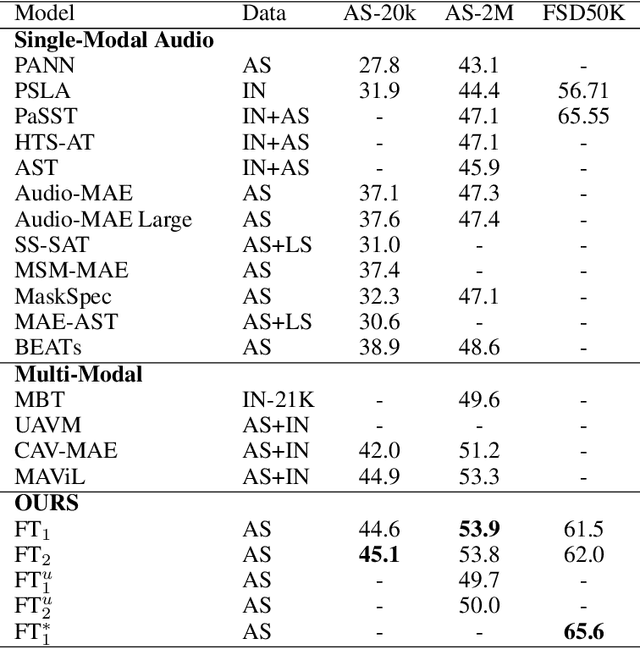
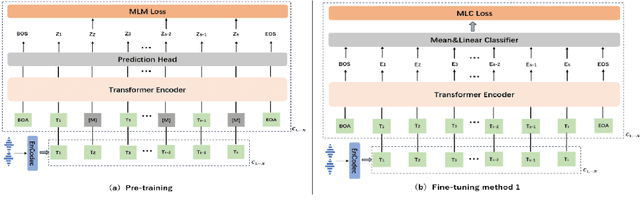
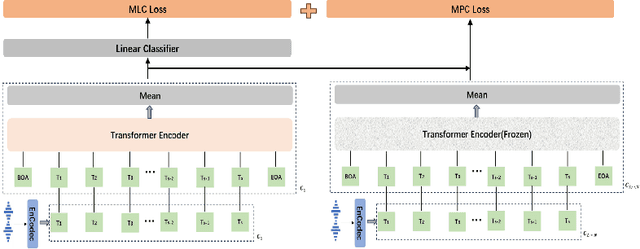
Abstract:We propose a method named AudioFormer,which learns audio feature representations through the acquisition of discrete acoustic codes and subsequently fine-tunes them for audio classification tasks. Initially,we introduce a novel perspective by considering the audio classification task as a form of natural language understanding (NLU). Leveraging an existing neural audio codec model,we generate discrete acoustic codes and utilize them to train a masked language model (MLM),thereby obtaining audio feature representations. Furthermore,we pioneer the integration of a Multi-Positive sample Contrastive (MPC) learning approach. This method enables the learning of joint representations among multiple discrete acoustic codes within the same audio input. In our experiments,we treat discrete acoustic codes as textual data and train a masked language model using a cloze-like methodology,ultimately deriving high-quality audio representations. Notably,the MPC learning technique effectively captures collaborative representations among distinct positive samples. Our research outcomes demonstrate that AudioFormer attains significantly improved performance compared to prevailing monomodal audio classification models across multiple datasets,and even outperforms audio-visual multimodal classification models on select datasets. Specifically,our approach achieves remarkable results on datasets including AudioSet (2M,20K),and FSD50K,with performance scores of 53.9,45.1,and 65.6,respectively. We have openly shared both the code and models: https://github.com/LZH-0225/AudioFormer.git.
Non-Integer-Oversampling Digital Signal Processing for Coherent Passive Optical Networks
Jun 20, 2023Abstract:Beyond 100G passive optical networks (PONs) will be required to meet the ever-increasing traffic demand in the future. Coherent optical technologies are the competitive solutions for the future beyond 100G PON but also face challenges such as the high computational complexity of digital signal processing (DSP). A high oversampling rate in coherent optical technologies results in the high computational complexity of DSP. Therefore, DSP running in a non-integer-oversampling below 2 samples-per-symbol (sps) is preferred, which can not only reduce computational complexity but also obviously lower the requirement for the analog-to-digital converter. In this paper, we propose a non-integer-oversampling DSP for meeting the requirements of coherent PON. The proposed DSP working at 9/8-sps and 5/4-sps oversampling rates can be reduced by 44.04% and 40.78% computational complexity compared to that working at the 2-sps oversampling rate, respectively. Moreover, a 400-Gb/s-net-rate coherent PON based on digital subcarrier multiplexing was demonstrated to verify the feasibility of the non-integer-oversampling DSP. There is almost no penalty on the receiver sensitivity when the non-integer-oversampling DSP is adopted. In conclusion, the non-integer-oversampling DSP shows great potential in the future coherent PON.
Theoretical Evaluation of the Capacity-Achieving Distribution for IM-DD Fiber-Optic Channels
Feb 23, 2023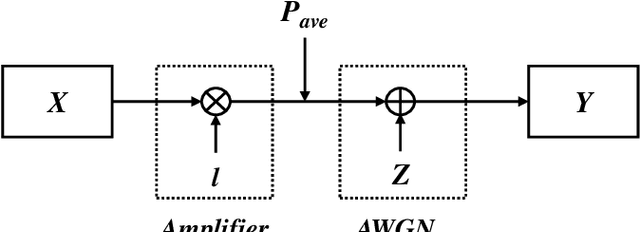

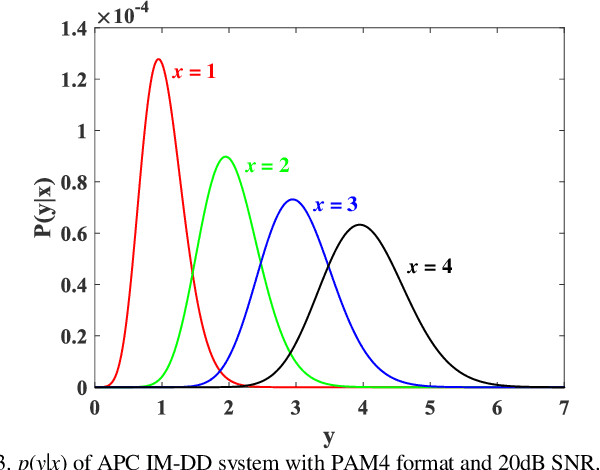
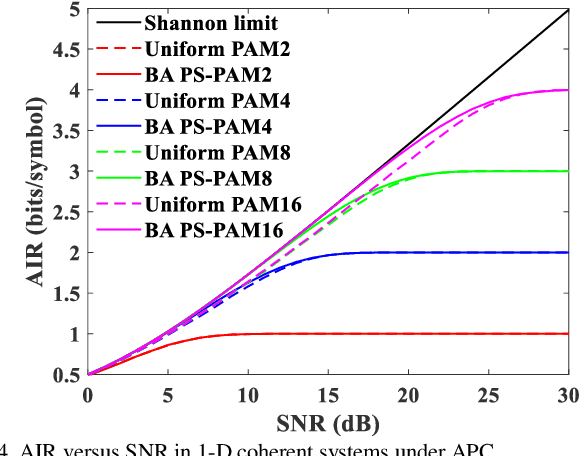
Abstract:The capacity and capacity-achieving distribution for intensity-modulation and direct-detection (IM-DD) fiber-optic channels is theoretically investigated. Different from coherent fiber-optic channels, we indicate that the capacity-achieving distribution of IM-DD systems should be discussed separately in two cases: 1) IM-DD systems without optical amplifier, which are constrained in peak power; 2) IM-DD systems with optical amplifier, which are the average power constraint (APC) system. For the two models, the maximum mutual information achieving distribution, instead of the maximum input entropy achieving distribution, is numerically computed by the iterative Blahut-Arimoto (BA) algorithm. For the IM-DD system under peak power constraint (PPC), a dynamic-assignment BA algorithm is applied to find the capacity-achieving distribution with minimum cardinality. It is observed that the maximum difference between the minimum input cardinality and capacity is around 0.8 bits. For a fixed support input cardinality, although the observed shaping gain is small and only appears in low peak-signal-to-noise ratio (PSNR) regions in the PPC IM-DD system, the probabilistic shaping technique can also be used to introduce rate adaptation to the system by adjusting the shaping and FEC overheads since the capacity-achieving distribution is symmetric. In the IM-DD system under APC, a modified BA algorithm is investigated to solve for the capacity and capacity-achieving distribution, and a significant shaping gain is observed. For PAM8 and PAM16 modulation formats, 0.294 bits/symbol and 0.531 bits/symbol shaping gain can be obtained at the SNR of 20dB. Furthermore, since the capacity-achieving distribution is asymmetric in this case, a practical discussion of the PS technique is also presented.
A Bayesian Robust Regression Method for Corrupted Data Reconstruction
Jan 08, 2023



Abstract:Because of the widespread existence of noise and data corruption, recovering the true regression parameters with a certain proportion of corrupted response variables is an essential task. Methods to overcome this problem often involve robust least-squares regression, but few methods perform well when confronted with severe adaptive adversarial attacks. In many applications, prior knowledge is often available from historical data or engineering experience, and by incorporating prior information into a robust regression method, we develop an effective robust regression method that can resist adaptive adversarial attacks. First, we propose the novel TRIP (hard Thresholding approach to Robust regression with sImple Prior) algorithm, which improves the breakdown point when facing adaptive adversarial attacks. Then, to improve the robustness and reduce the estimation error caused by the inclusion of priors, we use the idea of Bayesian reweighting to construct the more robust BRHT (robust Bayesian Reweighting regression via Hard Thresholding) algorithm. We prove the theoretical convergence of the proposed algorithms under mild conditions, and extensive experiments show that under different types of dataset attacks, our algorithms outperform other benchmark ones. Finally, we apply our methods to a data-recovery problem in a real-world application involving a space solar array, demonstrating their good applicability.
Inference of Nonlinear Partial Differential Equations via Constrained Gaussian Processes
Dec 22, 2022Abstract:Partial differential equations (PDEs) are widely used for description of physical and engineering phenomena. Some key parameters involved in PDEs, which represents certain physical properties with important scientific interpretations, are difficult or even impossible to be measured directly. Estimation of these parameters from noisy and sparse experimental data of related physical quantities is an important task. Many methods for PDE parameter inference involve a large number of evaluations of numerical solution of PDE through algorithms such as finite element method, which can be time-consuming especially for nonlinear PDEs. In this paper, we propose a novel method for estimating unknown parameters in PDEs, called PDE-Informed Gaussian Process Inference (PIGPI). Through modeling the PDE solution as a Gaussian process (GP), we derive the manifold constraints induced by the (linear) PDE structure such that under the constraints, the GP satisfies the PDE. For nonlinear PDEs, we propose an augmentation method that transfers the nonlinear PDE into an equivalent PDE system linear in all derivatives that our PIGPI can handle. PIGPI can be applied to multi-dimensional PDE systems and PDE systems with unobserved components. The method completely bypasses the numerical solver for PDE, thus achieving drastic savings in computation time, especially for nonlinear PDEs. Moreover, the PIGPI method can give the uncertainty quantification for both the unknown parameters and the PDE solution. The proposed method is demonstrated by several application examples from different areas.
 Add to Chrome
Add to Chrome Add to Firefox
Add to Firefox Add to Edge
Add to Edge